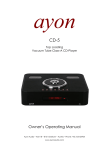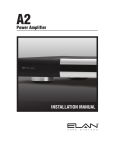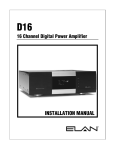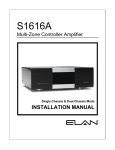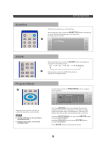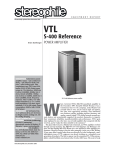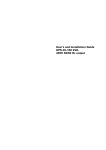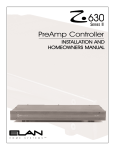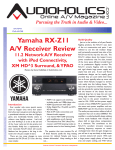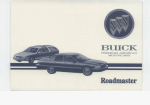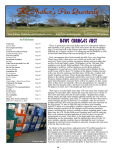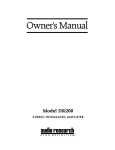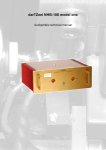Download Valve Renaissance Signature Mk II Specifications
Transcript
Ayon CD-5 reference CD player with integrated preamplifier Doug Schroeder February 2010 Specifications: Conversation rate 192kHz / 24 bit CD-Transport Philips CD-Pro 2 Tube complement – Analog output stage 4 x 6H30 Tube complement - Power Supply 4 x 6X4 Dynamic range > 110dB Output level @1 kHz / Rms - LOW 0-4V variable Output level @1 kHz / Rms – MED 0-6V variable Output level @1 kHz / Rms - HIGH 0-8V variable to drive a power amp directly Output impedance Single-Ended-RCA ~ 300 Ohms Output impedance Balanced-XLR ~ 300 Ohms Digital output S/PDIF (RCA), I2S, AES/EBU Digital input USB, AES/EBU, SPDIF, TosLink I2S Analog input 2 x Line In (RCA) Analog output RCA & XLR S/N ratio > 110 dB Frequency response 20Hz - 20kHz +/- 0.2dB Total harmonic distortion @ 1kHz < 0.002% Remote control Yes Dimension (WxDxH) cm 50x41x13 cm Weight 18 kg MSRP: $9,450 Distributor: U.S. / Canada / Mexico Ayon Audio USA Tel. 1-888-593-8477 URL: www.ayonaudiousa.com Email: [email protected] ©DAGOGO 2010 – special reprint by permission. Page 1 The adolescent Doug Schroeder When I was in my early teens I rode the Screamin’ Eagle rollercoaster at Six Flags St. Louis. What a memorable first ride! It must have been about 1977, maybe a year after the coaster opened, and it was a hot, sticky summer day. At the small band shell near the coaster a funky disco group called KC and the Sunshine Band jammed for riders. I waited impatiently for the front seat of the coaster to have my first ride. I was matched up with a teen girl of unmemorable description, and we bolted toward the sky. Well, actually we ka-chunk, ka-chunked our way as the chain pulled us upward to the first drop. One hundred ten feet high and sixty two mph – it was the “baddest” of the coasters at the time! As we reached the crest I let out a whoop. I turned toward my terrified co-passenger, encouraging her, “Put your hands up!” She had a death grip and was not letting go. We sailed around the track, swaying semi-violently as we were flung side to side in the bench seat. Once we hit the sweeping turn at the top, my extended elbow plowed into her head and sent her eye glasses plummeting into the blurry void below! I screamed over the coaster’s roar, “I’m SO sorry!” My arms were no longer extended. Profusely I apologized as we careened into the last turns and came to a stop. Exiting the ride I steeled myself against the horror to come which would include facing disgruntled mom and dad, apologizing repeatedly to her parents, humiliation and expense for replacement glasses. As I tried to face up to the circumstances, she became adamant, “GO! GO! I never wanted glasses! GO! Now I can get contacts!” She shooed me away like a stinky farm animal, “Go, now, before my parents come back!” I went (and there’s still a pinch of residual guilt about it). As I walked away I thought, “Wooooooooooooo!” Now THAT was a ride! ©DAGOGO 2010 – special reprint by permission. Page 2 It’s now 2010, I’m back on the Screamin’ Eagle, and no one’s glasses are going to get knocked off. But my hands are in the air, and I’m going, “Woooooooooooo,” as I listen to the Ayon CD5, “Now THIS is a Redbook ride!” I have had the pleasure of reporting on Ayon Audio, a company and components which are among the best designs to emerge in high-end two-channel audio in the latter half of the 1990’s. In particular, I’ve had the privilege of working with four players by the talented Gerhard Hirt, a man whom I sense, based on his designing prowess, has the potential to become an Icon in the audio industry. I am now at the peak, the summit, the crest of the wave, the top of the Screamin’ Eagle – Look out World! The Ayon CD-5 is here! Yah–hooooooooo! Ok, so that’s a bit overdone for a reviewer who’s supposed to be objective. Fine; let’s go with the alternative opening… As the landscape for media is changing rapidly, so is the nature of audio equipment. Who thought ten years ago that integrated amps would make a big splash in America at the turn of the millennium? Who would have dreamed that vinyl would have arrested its fall and turned upward in numbers of users and albums being produced? Who would have thought that the standalone preamp would be challenged by Redbook CD players? Yes, you read right, preamp…challenged by… CD player. Before we proceed, allow me to reassure that your preamp is likely not obsolete, that is, unless you own an Ayon CD-5. In that case, if you are like me you will find yourself streamlining your audio system to a degree not thought practicable only several years ago. You will be running your sources into your CD player, your CD player straight into your amps, and it will never have sounded better! In fact, as long as the Ayon CD-5 is in my room, it will be my explicit goal to see if, when building any system, I can avoida preamp and work solely with the CD-5 and amps. Surely, I jest, right? Wrong; I’m dead serious about building the best systems possible, and I’m dead serious about the CD-5 and amp combo. As of this product’s entry into the marketplace your preamp is not completelyobsolete, just mostly obsolete. If you have a hankering for top-notch Redbook, or to play steaming audio via digital coax or USB, then your preamp is obsolete if you obtain a CD-5. Why do I keep saying “obsolete”? Whereas most CD players contain no preamp function, or at best a functional but unimpressive level control, the CD-5 has an audiophile tube preamplifier function built in. It is impressive in quality such that only the very finest preamps will improve upon it. Gerhard points out that the Ayon Polaris II and Spheris, two-chassis dedicated preamps, are of higher caliber than that inside the CD-5. However, consider that when I was using the Ayon CD-2 I was already experiencing such good sound from the player direct to amp(s), through the elimination of a component and set of cables, the only preamp I had used which did not harm the sound simply by being in the chain was the VAC Renaissance Signature Preamplifier MkII, a $14K component! I have been spending a fair bit of time in the past two years working to perfect my rig as dual mode, operating either with a pre or without one, but at all times running at the highest fidelity. Using the CD-5, you can obtain results which will match or best most high fidelity systems using a dedicated preamp. ©DAGOGO 2010 – special reprint by permission. Page 3 C o ns tr uc ti o n Yo u mi ght thi nk that a rec kless statement to make, however you don’t yet know what’s inside the CD-5. Once you know that, you may see I’m not so reckless in that assertion. For starters, the player is huge, at 50 x 41 x 13 cm (approx. 20 x 12.5 x 5 inches) it is quite a bit larger than most players. More volume means more space to include a nice preamp section, which is precisely what Ayon has done. It’s massive with a capital M, with a half inch thick aluminum-brushed anodized black chassis bringing its weight to 45 pounds (18 Kg)! It’s much deeper and wider than most players, so take care with placement as it may not fit your current rack. No problem, get a different rack. No shelving should stand in the way of this purchase decision. You may want a different rack anyway; this player should not get stuffed in between shelves as it gives off much more heat than a traditional CD player - it has eight tubes inside. You’re going to want an easy access set up anyway, as it’s a pain to reach into a shelving unit to access a top loader. Externally the front mounted backlit top controls are expanded to include not only basic functions such as PLAY, STOP, PAUSE and SKIP TRACK, but also VOLUME +/- and INPUT. Should anything untoward happen to the remote, one is not SOL. Initialization process of discs continues to undergo refinement with the CD-5. In the CD-2, there were occasions when initialization did not occur properly approximately once every fifteen attempts. I would lift the lid slightly to re-seat the disc for initializing. With the CD-5 all such niggling adjustments have been banished; not once has a disc failed to initialize perfectly, and I might add quickly. Gerhard pointed out that the “misfire” was a slightly touchy MCU (or “error” correction chip), which in the CD-5 has been reprogrammed to work flawlessly. Even upon ©DAGOGO 2010 – special reprint by permission. Page 4 turning on the unit, the soft start “Warm Up” for tube life preservation is fairly rapid and the player is efficiently prepared for play. The rear of the unit is stuffed with connection options, included at this price level were the expected L/R single ended and balanced inputs and outputs, switchable via a toggle switch. The array of digital input options includes Coaxial, Optical, USB and AES/EBU. Similarly, digital outputs include SPDIF/RCA, I2S, and AES/EBU. The I2S output is of interest, as it supports fully 24bit/192kHz high resolution data. I would have dearly loved to have on hand the PS Audio Perfect Wave DAC to try with the CD-5 via the I2S, but as you will see below the circumstances prevented it. Some additional surprises include the two sets of analog inputs, labeled LINE 1 and LINE 2. The manual does not discuss them at length, however they are unusual in that they utilize an A/D converter to put them in the digital domain, then the signal is upsampled to the full 24 bit/192kHz! Similarly, the USB input is upsampled to 24/192, and according to Charlie Harrison of Ayon USA, will accept whatever high resolution signal you throw at it. This puts the CD-5 on similar turf with the PS Audio Perfect Wave, in converting disparate sources to a common standard. I have been futzing lately with an inexpensive analogue rig and was very pleased by the quality of sound sending the phono preamp’s outputs to the ANALOGUE IN of the CD-5. While it may seem incredible that an analogue signal would be converted twice, the result was highly satisfactory. With the CD-5, one has the luxury of being able to subject all sources to upsampling. Sources are not automatically subject to upsampling, it is optional and can be engaged for all inputs via the remote control. The red “Phase” light which was found on the CD-2 appears again. The manual notes clearly that its function is to indicate proper electrical phase and is not applicable to North American installations. Oddly, a Xindak FP-Gold power cord I had attached caused the red light to glow, and when I swapped it out for a Wireworld Silver Electra the light went off. It made me wonder if the Xindak was cross-wired so as to have reversed polarity, and how much it contributed to the Wireworld power cord sounding better. Charlie indicated that the LED in the sensor is extremely sensitive and seems to even respond to the electrical flow of individual cords differently. Who knows, maybe the light should be seen as a cable quality indicator? Finally, one of my favoritefeatures is the GAIN switch, which allows one to choose either Low or High gain. Interestingly, this switch has three settings, though only two are labeled. The lowest position being unmarked is set at 4V output, while the middle position “Low” is at 6V and the “High” at 8V. The Gain feature has the effect of causing lower-power amps, such as single ended triode (SET) amps, to be seen by speakers as having much more power. Consequently, lower efficiency speakers sound much more like higher efficiency speakers. Says Gerhard of the Gain feature, “…you can put more signal power in a SET driver stage….” Below I will discuss the benefits of this feature in my usage of the CD-5. Internally, the player has a full compliment of mechanical isolation goodies; absorber/damping feet, anti-resonance-damped mounted gold circuit boards and a suspension system isolating the CD….. Phillips CD-Pro 2 transport, four Burr Brown 1704K D/A chips, said by Gerhard to be, ©DAGOGO 2010 – special reprint by permission. Page 5 “…perhaps one of the best sounding D/A chips,” in a paired symmetrical configuration and switchable 24 bit/192kHz upsampling make for a solid design. Much of the magic of the CD-5’s sound is found in the highly cultivated power treatment, including a “dual choke” filtered and stabilized power supply with “bridge” tube rectification. P o w er T o T he Pe o pl e! Considering the power supply, I have seen firsthand the impact of good power supply for a speaker. Recently, I acquired the Kingsound “The King” full-range ESL following its review. This is an exquisitely fine panel speaker at an economical price. Part of the economy of the speaker is the hapless 12V power supply – nothing more than a common wall wart, which I jettisoned as quickly as possible. I replaced it with something more serious, the custom made VAC (Valve Amplification Company) “Royal” Power Supply, made by Kevin Hayes specifically for use with the King. These little boxes of energy gave the King a big leg up to reach their fullest potential such that I would be loath to operate the speakers without them. I enjoy well designed tube power supplies; VAC uses a tube power supply on the previously mentioned Renaissance Signature MkII pre and it’s an element of its superiority. I would not quickly trade away what the CD-5 does in terms of power management for the plethora of inexpensive “separate power supplies”, in some of the more popular solid-state CD player’s. Gerhard ventures, “We are using a special power supply… we think there is no other tube CDplayer at the moment which is using such a p.s.” He’s fairly tight-lipped about the details, but it’s obvious to the ear that the highest quality is being applied to this aspect of the player’s development. Which brings us to a process called “bridge” tube rectification. Normally, only one tube is needed and it works similar to a semiconductor design. The CD-5’s bridge rectification employs four tubes to handle the process. The advantage according to Gerhard is that, “… we can handle much more peak to peak current and we can increase dynamic headroom a lot.” The key is delivery of high current, hence the selection of the more expensive and difficult to work with 6H30 rectifier. ©DAGOGO 2010 – special reprint by permission. Page 6 Putting together, a sweet power supply, primo D/A converters, bridge tube rectification and other features like gold-plated PCB boards and central one-point earth grounding, it combines to make a superior topology, one that is heard as instantly recognizable as superior. A good example was the brief comparison made between the CD-5 and the McIntosh MCD500 SACD/CD player. Several days prior to the culmination of this review an audiophile friend who has heard the CD-5 in my system on two occasions had on loan the MCD500. He wanted a brief comparison to the CD-5; I agreed as I thought it would be interesting to see how the two compared. The CD-5 was quite a bit superior in every respect, especially in richness, smoothness, depth of the sound field, tonality and dynamics. My friend and I called a quit to the comparison fairly quickly as it was immediately evident that the players were not in the same league. It should be pointed out that the MCD500 is a $7,000 player, and the CD-5 is $2k more expensive. The distinction in sound was such that I would believe anyone who could afford either would not hesitate to own the Ayon. Remote Possiblity? In previous articles about Ayon players I have been hounding Gerhard to include a simpler remote, but to date it has not happened. This would have made the player an even more pleasurable device. I have been using four different Ayon players in the past two years, and still have to look at the controller every time I enter a command! If I listen in dim light I still have to slide my fingers along the rows of buttons until I find the proper one to advance a track. A simplified, cheaper remote for daily use would be most welcome. If it were made available now, I would acquire it to avoid the hassles with button overload on the remote, half of which I have not used with regularity. ©DAGOGO 2010 – special reprint by permission. Page 7 Regarding The Variable Output The player now arrives with the level set to “Min”, or no output. Previously the CD-2 arrived with it set to “Max”, which would present a slight problem should an unwitting owner breeze through the manual (No self-respecting audiophile does that, right?), and ignore the caution on level settings when hooking up power amp(s) directly. Now that the CD-5 arrives prevented from harming speakers, being set at the “Min” setting, I’m sure Charlie Harrison at Ayon will get several calls insisting, “My player doesn’t work!” It works; directions need to be read to make it work to satisfaction! I have an added advantage in using the Pathos Classic One MkIII integrateds, in that I can opt for either the player’s level control or the integrateds. There is a slight nuance difference in terms of dynamic impact, it being a bit better when the player is set to “Max” and level controlled by the Classic One units. However, when using power amps directly the CD-5’s preamp function is smooth and well calibrated to achieve fine enough gradations that one is not caught between settings too soft or too loud. In addition, it’s handy to manage track selection and volume from the player’s controller. Operationally the CD-5 is quiet. Aside from a soft click at the end of play, functions including initialization, are as silent as one could wish. The readout is a problem for those with poorer eyesight at a distance, though it should be tolerable for those with good eyes. Aesthetically, the graceful curvature of the aluminum chassis is business-like and self-confident, not drawing undue attention. One can flip through the INPUTS either by remote or the top-of-player controls. Inputs which are active appear solidly illuminated while inactive inputs flash. Operating the CD-5 occasionally means having to flip a switch on its backside. Moving from RCA to XLR outputs means tripping a toggle, as does a change to the GAIN setting. Occasionally I will switch inputs on the integrated amps in order to hear a comparison between interconnect cables, only to be reminded by the silence that the RCA/XLR switch had not been touched. Most users will only have one set of speakers or interconnects so that once the settings have been achieved they won’t need to be adjusted for quite some time. However, I do suggest the option of two pairs of interconnects for variety or in handling difficult recordings. Magical Melding Of Upsampling And Gain In my initial comments I enthused about the GAIN feature of the CD-5, and indeed this sets the player apart from virtually all other Redbook sources. An apodizing filter to control pre- and post-ringing on the signal is a hot new technology employed in high-end players. However, Gerhard will have nothing to do with it, “We do not use this and believe it can impair sound quality.” Instead, he has focused on the player’s gain. A while back I reviewed the Eastern Electric BBA Buffer Amp, which is a tube preamp with single RCA input and a variable Gain ©DAGOGO 2010 – special reprint by permission. Page 8 control. This was a fun device as it allowed not only for control of the level but also influencing the sense of intensity of the signal. Combine the GAIN feature with the ease and openness of upsampling to 24 bit/192 kHz and the player takes on a lush, smooth sound which is quite addictive. I have generally not used the upsampling feature of players; while it “fills in” the music a bit it tends to smear the signal slightly. While the music becomes more analogue-like it also is less precise. The CD-5’s GAIN feature, however, works magic with upsampling such that I’m less disturbed by the extraneous information in the signal. The music sounds as though less converted and more diverted, as if it’s a stream guided in a different direction but not significantly polluted. What Does It Profit To Gain The Whole World? The GAIN feature of the CD-5 is a potentpart of its capabilities. I was pleasantly surprised by its ability to leverage the sense of power and scale. I had two perfectly affordable reference speakers on hand to investigate how it works, the Legacy Audio Focus SE at 4 Ohm 96 dB sensitivity, and the Kingsound King, having 83 dB sensitivity and requiring an amp which can handle a dip below 2 Ohms. The Focus SE has proven to be fairly easy to drive, while the King is, shall we say, difficult. Speaking first in regard to the King, it is a speaker which benefits greatly from stout amplifiers, like the Moscode 402Au amps. The Pathos amps drove the King speaker with authority. ©DAGOGO 2010 – special reprint by permission. Page 9 However, the GAIN feature of the CD-5 allows more conservatively (under 150wpc), or even pusillanimously rated (under 50wpc), amps to be juiced in terms of dynamic power. The effect is heard immediately when the toggle on the back of the CD-5 is moved from the 4V default output position to Low (6V), then to High (8v). The switch can be adjusted on the fly, however, I strongly recommend doing so at low listening level. The sound will cut out only momentarily while the switch resets. Making the adjustment while standing to the side of these panel speakers, the distinction was easily audible. I had a pair of audiophile friends over to hear the rig with the Ayon and as I adjusted the switch they immediately said, “I can hear that!” I’ll describe the effect as an illuminating of the sound, nearly like a three-way switch on a lamp – more of the same but at a higher intensity. It’s an interesting phenomenon as the sound thins ever so slightly, but sounds more corporeal at the same time. Think of it like make up on a woman; if it’s caked on she’ll look like a mannequin, but if it’s thinner more of her skin and natural complexion shows through, a much more desirable result. In addition, there is an inflation of the system’s acoustic envelope. Whereas the sound stage might be considered about 10 feet wide perceptually, with additional gain it expands to about 12-14 feet wide and deepens considerably. The GAIN settings arepowerful in effect, such that I chose not to use the High Gain setting with the King. The exploded soundstage was so expanded with these panel speakers that the King made it seem too wide, almost as though the solidity of the instrument or voice was being atomized and the localization of the voice or instrument in the center of the field expanded too far. The Off, or null, setting was perfect for the King for most music. However, I did notice that quiet pieces, simpler works of solo instrument or ensembles, benefited by upping the gain from default (4V) to the Low setting (6V). On lilting songs like Erin Bode’s “Chasin’ After You”, one could hear so much more of her inflection and intonation that it was thrilling! In the same way that sitting at a sporting event in the upper seats is not as involving as being seated in the lower stands, one can consider the GAIN switch to allow you to “switch seats”, moving closer to the performers with each increase in gain. However, there is a limit in any given system to the amount of gain which contributes positively. After a certain point, the sense of power begins to corrupt, and we all know what absolute power does! Taking the GAIN setting to the High position resulted in an overage of intensity whereby bass notes began to ring a bit too much, the treble become too spatial, the voice a bit vacuous. This would be expected as I was working with powerful amps. One can easily find their own perfect setting, and I found that I was not often adjusting the switch; once set it could be counted on to sound satisfying for all genres of music. I can foresee many people simply setting it once and forgetting it, while tweakers would be in their glory discovering how every artist would play given the different settings. ©DAGOGO 2010 – special reprint by permission. Page 10 4 Ohm Speakers Become 8 Ohm Speakers! The real fun was had with the GAIN setting used in conjunction with the Legacy Focus SE speakers, VAC Renaissance Signature Preamplifier MkII and Moscode 402Au amplifiers (two used in Biamp mode). These speakers are not terribly difficult to drive, and even though they are 4 Ohm speakers they are 96 dB sensitivity. However, with the Gain setting of the CD-5 only at the null position, at a 4V output, these speakers came to life like I have never heard them prior. They snapped to attention as though they were 8 Ohm speakers, with a crushing bass at 16Hz and numinous highs. Bumping the GAIN setting to Low (6V) upped their perceived efficiency to sound like 12 Ohm speakers; with each increase in gain the speakers had more “jump factor”, more pumping bass, creamy mids and tingling highs! The jump in power was evident by the digital readout on the Pathos amps. Prior to using the CD-5 and the Low gain function I had to run these speakers in the 40’s, but with it, I could achieve high levels (approx. 90 dB at 12 feet) with the setting at 20! Consequently, I could not optimally run the High Gain setting with these speakers either. Though the speakers handled it, once again the sound became unduly expanded and lost focus. Truly, amps are given staggering increases in presence through this feature! High Power + High Gain = Noise When I was familiarizing myself with the Legacy Audio Helix speaker system, I was surprised to hear a faint, continuous hum caused not by the media, nor a ground loop, but from the amplifier itself. This is not an uncommon occurrence. Initially it was frustrating, as ideally there will be dead silence when there is no signal. However, there are situations in which the additional low©DAGOGO 2010 – special reprint by permission. Page 11 level noise is tolerated in exchange for a much greater dynamic performance from the speakers. In the case of the Helix, which is 102dB sensitive, I was using six channels of Jeff Rowland’s MC-606 with 2,500wpc, so an elevated noise floor was part and parcel of the nature of the rig. I also accepted a certain amount of noise when I built several systems using the Tannoy Glenair speakers. I found there to be a similar relationship between the voltage output of the CD-5, the preamp and the power amplifier. Two amplification setups exhibited a higher-than-normal noise floor, both pertaining directly to the use of the CD-5. One was the very high-end combo of the VAC Renaissance Signature Preamplifier MkII and two Moscode 402Au Amplifiers, and the other was a pair of Cambridge Audio Azur 840W amplifiers wired direct from the CD-5. In one case, a preamplifier was used and the amplification components were at a valuation of approximately $30K. In the other, the CD-5’s internal preamp was used and the valuation of the amps were approximately $5k. What, then, would be the common factor between these two setups? High power, namely the utilization of very high power in conjunction with the CD-5’s higher gain output, resulting in an elevated noise floor. I had encountered this with the CD-2 when I used the 1,000 wpc Jeff Rowland 501 monoblock amps. It was manifested in a metallic sounding “ping” when the player was engaged. Though supposedly eliminated from the CD-5, I found that it still exists when the conditions are right. This is a significant flaw. Ideally no noise should emanate from a player; however, most players are not attempting to feature variable gain and thereby offer audiophiles an ingenious improvement over standard Redbook playback. The weakness in such a design is the additional noise it introduces to the system when used with high-power amps. Anyone using a lower-power amp should never encounter it. With my Pathos Classic One MkIII integrateds running mono at 170wpc into 8 Ohms and 270 wpc into 4 Ohms, it never manifested itself no matter what speaker was used. ©DAGOGO 2010 – special reprint by permission. Page 12 For those who may encounter it, let me assure you that it’s a mixed result, not all bad. The noise is not appreciated, however the proportionately large jump in macro and micro dynamics is so good that one is tempted to accept the noise for the improvement in visceral impact of the experience. Just as vinylphiles accept a higher noise threshold to attain the analogue sound, I’m very tempted to ignore the elevated noise floor to experience the immediacy and vitality which the high power/high gain rig produces. Once the music started, the Legacy Focus SE speakers acted as though they had been hot rodded. I have never heard them sound so much like an oversized monitor, with all the attributes of a full-range, but the punch, quickness and vibrancy of a smaller speaker. What if you currently have a higher-power amp, say 300wpc or higher, and you wonder if the Ayon would work for you. You need to answer a few questions: Can you accept the possibility of an elevated noise floor for a greatly elevated overall performance? If your answer is no, that you need absolute silence in the silent moments in the music, then you have two options: Ignore this player, or – and I am perfectly serious – get the CD-5 and ditch the amps. Knowing the Ayon player as well as I do, I would likely keep it and look for other amplification. My reasoning is that there are many amps which can do well with the CD-5, but there are very few players I know of which can do what the CD-5 does. The amps which will be most highly benefited are lower-power, say, 25 wpc or even less and made for highly efficient speakers. The theory is, with use of the High Gain setting, such amps will be given enough power to handle more inefficient speakers. This opens up a new world for people to combine low power amps with inefficient speakers, possibly even magnetic planars or electrostats! Maddeningly, I do not have any SET amps on hand now to test this! Low-power amps are not typically recommended for panel speakers because they have difficult impedance curves and are so tough to drive that they can even prove fatal to the amp. For those who cannot part with lower-power amps, outboard transformers such as the Speltz Autoformer are available. However, Ayon has now given a cause for single-ended triode fans to celebrate, as it seems another option is on the table with the CD-5. If you are a low-power amp fan and are curious about the CD-5, you should consult with Ayon Audio to gain assurance regarding potential combinations of amp and speaker. I also would caution the use of the CD-5 along with a low-powered amp and a device like the Speltz Autoformer. Consult with all manufacturers involved to arrive at your decision regarding usage. Jumbo Jet Disappearing Act It has been asserted that big speakers cannot “disappear”, that is, throw such a deep and spacious soundstage it’s as if they aren’t there. Just as magicians cannot get a jumbo jet to disappear if the stage is not set properly, so will you not be able to hear this effect if you don’t have your speakers set up properly in the room. I had obtained this result wonderfully with the Wharfedale Opus 2-M2 monitors as I had them five feet from the head wall, approximately six feet apart and 8 feet from my listening chair. The sense of the music emanating from far beyond the speakers themselves was very strong and the experience most satisfying. When such a convincing result is ©DAGOGO 2010 – special reprint by permission. Page 13 achieved, it becomes easier to see why some enthusiasts prefer some monitors even when they could own certain floor standing speakers. While it can be fairly easy to set up monitors to pull off this “disappearing act”, it is not so easy for larger speakers, especially panel speakers. Prior to using the CD-5, I had not heard larger panel speakers disappear so convincingly in my room. One reason is that it is not a larger space, being 23’ x 13’. However, the Ayon is so good at enlarging the acoustic envelope that this helps in the creation of this effect. With the Kingsound King I was able to set up a fairly convincing example of larger speakers disappearing. In this case, the Kings were approximately 8 feet apart from each other’s inside edges, and four feet from the head wall. Considering the King is a speaker 6 feet all and 28” wide, they were quite adept at getting out of the way when playing live recordings in a fashion I would say was a semi-disappearing act. What made this experience so special was the ability of the CD-5 to, convincingly, not only set the vocalist deep into the center phantom image, but to fool my ears into thinking they were hearing spatial clues of reflections of a venue as if the sound was emanating from a distance. While I have heard other CD player’s move a voice forward or back in relation to the plane of the speakers, I have never heard one so thoroughly fill in the space between it and the speaker plane to create such a 3-D “acoustic hologram” of a performance. I have never heard any player, nor transport/DAC combo, come this close to sounding convincing. It makes players like the Cambrige Audio Azur 840C, the Rega Saturn, and yes, truthfully, even the Ayon CD-2 to a lesser degree, sound flat and twodimensional. Compared To PS Audio Perfect Wave Transport and DAC A few weeks prior to the arrival of the CD-5, I had developed a keen curiosity to hear PS Audio’s hot new product, the Perfect Wave Transport and Perfect Wave DAC. It seemed every reviewer covering digital products wanted a set and there were few to be had. Dave Kackenmaster of PS Audio had initially estimated delivery time for a review set in November of 2009, but the date kept getting pushed back further due to demand for them. I was interested in hearing them sooner rather than later, so when Brian Tucker of Pro Audio Ltd. in Barrington, Illinois was leaving town for a week, I arranged to hear his set in my room. It was a fine demonstration of the outer limits of Redbook capabilities. When I had to return the combo I was disappointed and thought that I would likely not hear such a nuanced performance again in my room any time soon. ©DAGOGO 2010 – special reprint by permission. Page 14 How wrong I was! Only several weeks later the CD-5 arrived. Had the arrival of the Ayon not been delayed for similar reasons, I would have been able to discuss a head-to-head comparison. I was preparing for a letdown but instead got a big pick-me-up as the Ayon was every bit as exciting as the Perfect Wave! I could hardly believe my ears, as the same exquisite detail, deft handling of treble, and extended bass with a far more nuanced presentation than normally heard from Redbook was once again filling in my room. The key impression I note between these two excellent sources is the difference in perception of “weight” or solidity. Both of them had superb detail retrieval, however as I spent a week immersed with the Perfect Wave I felt repeatedly that I was reliving my experience years prior of ownership of the PS Audio HCA-2 amp, that being Class D. I did not own that amp terribly long as it seemed a bit facile, a tad too sterile, and light in the bottom-end. It was my first introduction to Class D, so initially I was impressed with the power, but over time I was disenchanted with it sounding too lightweight. The Perfect Wave gave me a similar feel. After a week of using it I was still working with cables aggressively to address that lean and underweight sound. When the CD-5 was inserted into the system one of my first reactions was, “Yes! Now there’s substance!” It would have been a very interesting comparison between these two, as I think the Perfect Wave might be a hair more exact. But my ear tells me the CD-5 is a fair bit more inviting. In the weeks following, it has not taken much time at all to conclude that I could easily consider the Ayon my reference without pining for the Perfect Wave combo. Gerhard is doing some things in CD player design which are as exciting as any products currently available. Exquisite Sound Exquisite is the proper word to describe the sound of the CD-5. This is the closest to a perfect player I have used; apart from the Gain/amplifier matching question, it is difficult to find a meaningful criticism of it. It would take another reference quality player to discover what one might consider a weakness in its presentation as it is a very complete, well-rounded source. Whereas most CD player’s show their weaknesses readily, being edgier, veiled, clinical, lacking in bass, lacking in separation of the instruments, not good with older recordings, not good with certain types of music, etc. the Ayon excels in every aspect I have examined. In comparison to the CD-2, the CD-5 is far more refined much more capable of rendering a deep and realistic sound space. It reveals more information but in an utterly smooth, appealing fashion. It also digs deeper in the bottom-end, refining and extending what is heard from the CD2. This player absolutely refutes the assertion that along with higher detail is higher listening fatigue. I have listened to this unit for countless hours and have not had tiredness from harshness of listening to digital media at all. One of my tests for high-end shrillness and fatigue is to listen at higher levels to sopranos. I’ll crank up Celine Dion or Sixpence None the Richer and see if my ears can take it for half an hour. If the system has treble which is too hot, then I’ll find myself turning it down to escape the sonic ©DAGOGO 2010 – special reprint by permission. Page 15 assault. But this never happens with the CD-5, nor does it with rock bands like U2 or Tears for Fears. Where Does The CD-5 Stack Up? Audiophiles are constantly looking for a realistic comparison, a scale if you will, by which to get a straightforward perception of how different components stack up. I will give you myscale, a quick take on how some of the Redbook players I’ve used in the past three years rate, by referring to a ladder’s rungs, positioning them in order of lowest to highest. Let’s begin at the first rung of the ladder, which is in no way to indicate absolute quality, but merely to compare to other players I’ve used. Here is how my “Ladder of CD Players” would look: 1st Rung: Ah! Njoe Tjoeb 4000 with Upsampler 3rd Rung: Rega Apollo 5th Rung: Rega Saturn 6th Rung: Ayon CD-1 8th Rung: Cambridge Audio Azur 840C 9th Rung: Ayon CD-2 and Now an extension needs to be added to the ladder… 13th Rung: *PS Audio Perfect Wave Transport/DAC 15th Rung: Ayon CD-5 *Note: Perfect Wave rating based on one week demo in my room; I freely admit this is not enough time to render a definitive judgment. This illustration should impart several of my conclusions regarding the CD-5 in terms of sonic satisfaction, most obviously that I find it in a different category from most others. It also holds ©DAGOGO 2010 – special reprint by permission. Page 16 the greatest improvement in terms of increasing quality over any other step up in players I used. It is clearly the best of the Ayon players as well. One might suggest that it had better be far superior at the price point. Don’t doubt, it is… by a long shot. In fact, thinking back to all the sources I have heard and elevation of performance between sibling players, this may be the largest disparity in absolute performance I have encountered. Back To The System Drawing Board? The CD-5 is the kind of player which makes one rethink sources. I mean really rethink them, as in, “Why have I always spent such an insane amount on speakers when a source can make this much of a difference?” To that end, I can’t believe I’m saying this, I wouldn’t have dreamed of suggesting it years ago: overweighting spending on speakers may not be the absolute best means to achieve one’s dream of a no-holds-barred system. I can see working with the CD-5 and a budget of an additional $25-30K to arrive at a rig which would rival a fair number of $100K rigs at this past CES. So good is the quality of the CD-5’s sound that it’s the only Redbook player I’ve used that I could confidently suggest one purchase first, then assemble the rest of the rig around it. Like I said, this year several rooms at CES and T.H.E. show used the CD-2. Next year, if they’re smart they’ll use the CD-5! I know of at least four or five rooms which I left thinking, “If they had used the CD-5 they would have sounded waaaay better.” Superlative Streaming I have not entered yet into the realm of USB connected sources for high-end listening; however, I have been using Sonos Digital Music System, which I link to my CD player or DAC through a coaxial digital cable. For this review I relied upon Wireworld’s Gold Starlight 6. I have yet to hear the Sonos sound the equal of my Redbook source, though it can come close. To give a sense of how good streaming audio can sound through the CD-5, even though I no longer have the CD-2, I would liken the sound of it to the CD-2. In fact, the performance of the CD-5’s DAC section is so strong that with upsampling of the Sonos’ signal, the resultant sound may be better than the CD-2’s Redbook performance! I admit I’m going on memory, but in use of the player the past pattern holds, meaning streaming audio input into Ayon players sound surprisingly close to their Redbook sound, so good is the processing. Just prior to the arrival of the CD-5, I was giving serious consideration to a modification of the Sonos unit. The itch to do so has largely been scratched due to the upsampling by the Ayon. Zipping through a playlist I created to assess the quality of streaming audio in a rig I was finally satisfied enough with the sound quality to begin using it as a source for reviewing. Up until this point, I have refrained from using streaming music or Sonos as a tool for reporting on equipment as it has not been up to my standard. Now, with the sound quality better than the majority of Redbook players on the market, it is suitable. It should speak volumes when an economical ©DAGOGO 2010 – special reprint by permission. Page 17 internet based device can deliver much higher than average CD sound. The credit goes to the superb upsampling DAC in the CD-5, and a premier digital cable in the Gold Starlight 6. Your Choice The question to be asked about the CD-5 is not, “How good a player is it?” It’s really good, reference quality good. Rather, it is a question of what kind of system is desired. Sure, you can run the thing as a stand alone player, which I would certainly recommend to those who have near pinnacle quality attending components. For the rest of us the question becomes, “Do I really need a preamp for my two-channel rig?” In many of the best sounding systems I have built, the answer is “no”. The CD-5 can become your player and your preamp. With its prodigious capabilities it can do so at a level which exceeds all but the best preamplifier and CD player combos. In fact, I think it would be very difficult to find a pairing of player and preamp which could perform at the level of the CD-5 for the same total price. Remember, such a rig would have to overcome the degradation of the signal from the addition of a component and a set of cables. What makes this Ayon so ©DAGOGO 2010 – special reprint by permission. Page 18 formidable is that it’s the complete package – screamin’ good Redbook, a clean and rich sounding preamp stage, chocked full of inputs, with looks and a U.S. distributor with a good track record. Gerhard Hirt has come up with another player with an extremely attractive set of attributes. Aside from some potential matching issues, it has the capacity to help audiophiles radically improve not only Redbook listening but entire system development! The CD-5 is unlike any Redbook player I have ever used; it does things unlike any player and makes me want to hold tightly to it and beat back anyone who would try to take it away! ©DAGOGO 2010 – special reprint by permission. Page 19



















